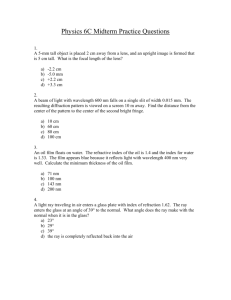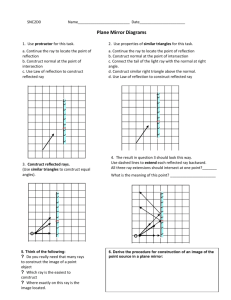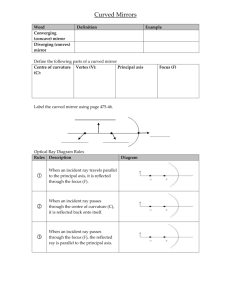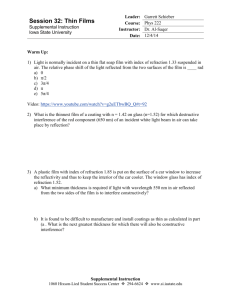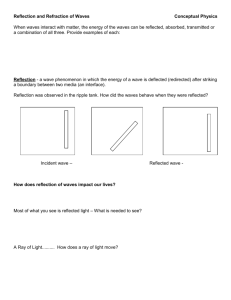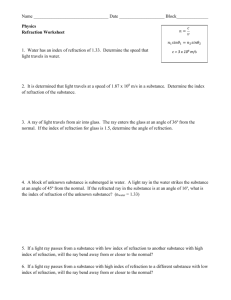Physics 6B Practice Questions
advertisement
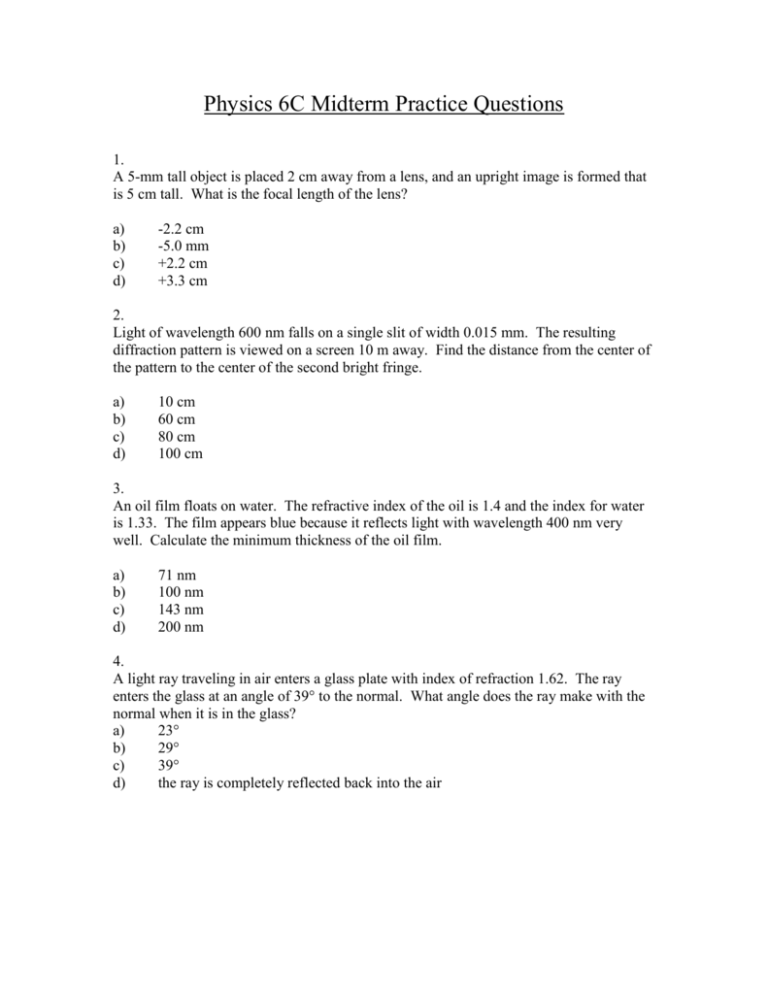
Physics 6C Midterm Practice Questions 1. A 5-mm tall object is placed 2 cm away from a lens, and an upright image is formed that is 5 cm tall. What is the focal length of the lens? a) b) c) d) -2.2 cm -5.0 mm +2.2 cm +3.3 cm 2. Light of wavelength 600 nm falls on a single slit of width 0.015 mm. The resulting diffraction pattern is viewed on a screen 10 m away. Find the distance from the center of the pattern to the center of the second bright fringe. a) b) c) d) 10 cm 60 cm 80 cm 100 cm 3. An oil film floats on water. The refractive index of the oil is 1.4 and the index for water is 1.33. The film appears blue because it reflects light with wavelength 400 nm very well. Calculate the minimum thickness of the oil film. a) b) c) d) 71 nm 100 nm 143 nm 200 nm 4. A light ray traveling in air enters a glass plate with index of refraction 1.62. The ray enters the glass at an angle of 39° to the normal. What angle does the ray make with the normal when it is in the glass? a) 23° b) 29° c) 39° d) the ray is completely reflected back into the air 5. A light ray in glass (index 1.62) is incident on an glass/air interface at an angle of 39° to the normal. What angle does the ray make with the normal when it leaves the glass and enters the air? a) 23° b) 29° c) 39° d) the ray is completely reflected back into the glass 6. Unpolarized sunlight is incident on a Polaroid filter. The light that is transmitted then encounters another filter whose transmission axis is at an angle of 34° to the first one. What percentage of the original sunlight intensity is transmitted through the second filter? a) 0% b) 34% c) 68% d) 83% 7. An object is 4m away from a wall. You are to use a concave mirror to project an image of the object on the wall, with the image 2.25 times the size of the object. What should the radius of curvature of the mirror be? a) 1.1m b) 2.2m c) 4.4m d) 5.5m 8. A double-slit experiment is performed with light of wavelength of 500 nm, and the first dark fringe appears at a distance of 4cm from the central bright maximum. If this experiment is now performed with the same setup, but underwater, how far from center will the first dark fringe be? Assume the index of refraction of water is 1.33. a) 2 cm b) 3 cm c) 4 cm d) 5 cm 9. Quincy Magoo is a man with poor eyesight. The farthest object he can see clearly is only 15 cm away. Find the lens power (in Diopters) that will correct his nearsightedness so that distant objects will appear clear to him. a) -15.0 b) -6.67 c) -1.50 d) +1.50 10. At a point in space an electromagnetic wave is propagating in the negative x direction. At a certain instant, the magnetic field of the wave at this point is in the positive y direction. At this point and this instant, the electric field of the wave is A) B) C) D) in the positive z direction in the positive x direction in the negative y direction in the negative z direction 11. A certain part of the electromagnetic spectrum ranges from 200nm to 400nm. What is the highest frequency associated with this portion of the spectrum? (1nm= 10-9m) A) 1.50 x 1014 Hz B) 7.50 x 1015 Hz C) 1.50 x 1015 Hz D) 7.50 x 1014 Hz 12. Polarizer 1 has a vertical transmission axis. Polarizer 2 has a transmission axis tilted 45° from the vertical, and polarizer 3 has a horizontal transmission axis. The light incident on polarizer 1 is polarized vertically. If polarizer 3 is removed, what will be the effect on the intensity of light at point P? A. the intensity will be zero (no light will emerge from polarizer 3) B. the intensity will increase by a factor between 1 and 2 C. the intensity will decrease, but will be greater than zero D. the intensity will be unchanged E. the intensity will increase by a factor of 2 13. Which of the following is the correct order of the electromagnetic spectrum from low to high wavelength? a) Radio waves, microwaves, infrared, visible, ultraviolet, x-rays, gamma-rays b) Radio waves, microwaves, infrared, visible, ultraviolet, gamma-rays, x-rays c) Gamma-rays, x-rays, ultraviolet, visible, infrared, microwaves, radio waves d) X-Rays, ultraviolet, gamma-rays, radio waves, visible, infrared, microwaves 14. If a double-concave lens that is normally used in air is placed in water instead, does the focal length increase, decrease, or stay the same? a) Decrease b) Stay the same c) Increase d) Cannot be determined from the information given 15. A light ray is in water is incident at an angle of 22.8° on an oil film with thickness 560 nm and index of refraction 1.45. Does the light ray bend toward or away from the normal? Assume that the index of refraction of water is 1.33. a) Toward b) Away c) The ray does not bend at all. d) The ray is completely reflected. 16. A horizontal ray of light encounters an upside-down prism. After passing through the prism, is the ray of light a) deflected upward b) still horizontal c) deflected downward d) cannot be determined from the information given 17. A 3-cm tall object is placed 50 cm away from a diverging lens of focal length 25 cm. Describe the image. a) The image is real, 1.5-cm tall, 25.0 cm on the same side as the object. b) The image is virtual, 1-cm tall, 16.7 cm on the same side as the object. c) The image is real, 3-cm tall, 50.0 cm on the other side of the lens. d) The image is virtual, 1-cm tall, 16.7 cm on the other side of the lens. 18. You are looking down on a puddle of water. When a thin oil film spreads out over the puddle, the thinnest part of the film looks dark. This tells you that the index of refraction of oil A) B) C) D) is greater than that of air and greater than that of water is less than that of air but greater than that of water is greater than that of air but less than that of water is less than that of air and less than that of water 19. You pour a thin film of benzene (index of refraction 1.50) on top of a flat piece of fused quartz glass(index of refraction 1.46). The benzene film is 10 µm (= 10,000 nm = 10-5 m) thick, and there is air above the film. You shine violet light of wavelength 400 nm straight down on the film and look at the light reflected back upward. As the benzene evaporates, A. the brightness of the reflected light will gradually decrease; just before the last of the benzene evaporates, the reflected light will be very dim B. the brightness of the reflected light will gradually increase; just before the last of the benzene evaporates, the reflected light will be very bright C. the brightness of the reflected light will alternately increase and decrease; just before the last of the benzene evaporates, the reflected light will be very dim D. the brightness of the reflected light will alternately increase and decrease; just before the last of the benzene evaporates, the reflected light will be very bright 20. Two telescopes are to be placed in orbit. One telescope is designed to be used with visible light of wavelength 500nm, while the second telescope is designed to be used with infrared light of wavelength 2000nm = 2um. In order that both telescopes have the same resolution, the mirror of the infrared telescope must have A) B) C) D) E) ½ the diameter of the visible-light telescope’s mirror 2 times the diameter of the visible-light telescope’s mirror 4 times the diameter of the visible-light telescope’s mirror 16 times the diameter of the visible-light telescope’s mirror ¼ the diameter of the visible light telescope’s mirror Answers: 1c; 2d; 3a; 4a; 5d; 6b; 7c; 8b; 9b; 10a; 11c; 12e; 13c; 14c; 15a; 16a; 17b; 18a; 19c; 20c

